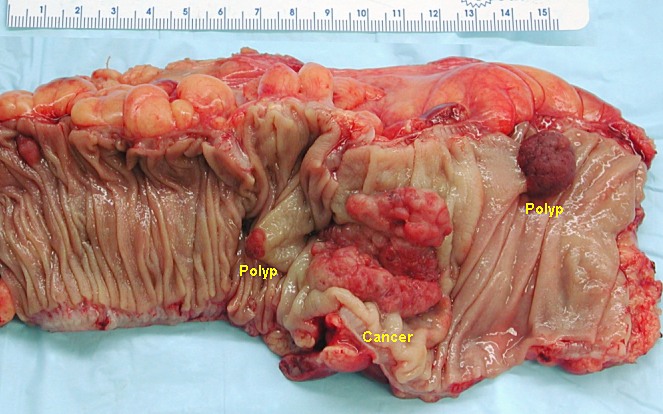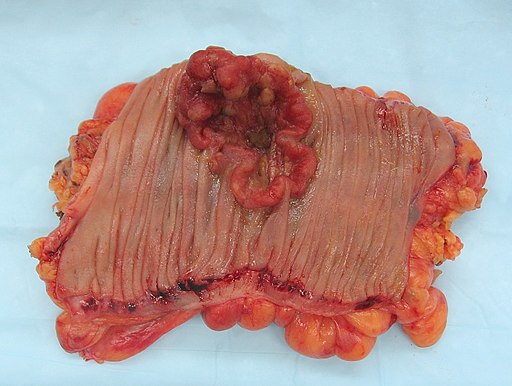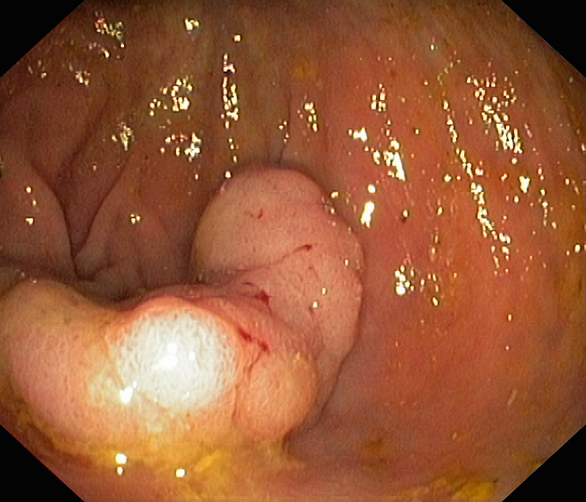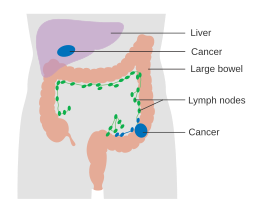Colorectal cancer
Definition and classification
Cancer that develops in the colon and/or the rectum.
Epidemiology
Third commonest cancer in the UK (after breast and lung)
40,000 people newly diagnosed each year
16,000 people died from bowel cancer each year
Incidence rate 50 per 100,000
The estimated lifetime risk of being diagnosed with bowel cancer is 1 in 15 (7%) for males, and 1 in 18 (6%) for females born after 1960 in the UK.
Incidence strongly increases with age, with trend starting at age 50y.
75% occur in people aged >65y; more common in men than women
Incidence higher in higher-income countries (Europe, North America, Oceania) and lowest in south and Central Asia and Africa.
Etiology
Genetic predisposition interacting with diet and lifestyle interventions.
Generic and molecular evidence to suggest most colorectal cancers develop over 10 years from colonic adenomas (polyps) that have acquired stepwise genetic mutations.
Benign colonic adenoma —-> Dysplastic pre-malignant colonic adenoma —-> Colonic cancer
Risk factors (many of which are modifiable)
Age> 50y
Family history of colorectal cancer
Personal history of inflammatory bowel disease (UC, Crohn’s)
Smoking
Excessive alcohol
High consumption of red and processed meat
Obesity
Polyposis syndromes: Familial adenomatous polyposis (FAP) and hereditary non-polyposis colon cancer (HPNCC, Lynch syndrome) are autosomal dominant inherited disorders that account for 3-5% of all colorectal cancers.
Pathology
Colorectal cancer is usually an adenocarcinoma.
Two-thirds located in colon, one-third in rectum.
Locally invasive, most common site for metastatic spread is the liver.
Diagnosis
Endoscopy (preferred if no major co-morbidities): Colonoscopy +/-biopsy
Alternatives (if major co-morbidities): flexible sigmoidoscopy +/-biopsy followed by barium enema or computed tomographic colonography (CT colonography).
However, if CT colonography identifies a lesion, histological biopsy by colonoscopy is required to confirm the diagnosis.
Other useful investigations:
Blood: FBC to identify iron-deficiency anaemia
Elevated pre-treatment serum levels of carcinoembryonic antigen (CEA) have:
A negative prognostic significance
No value in screening
May predict relapse in patients after surgery suitable for further resection
No usefulness for screening
Staging
Colorectal cancer: contrast-enhanced CT of chest, abdomen and pelvis [+ contrast-enhanced MRI Brain if intracranial disease is suspected and/or PET-CT]
Rectal cancer: MRI +/- endorectal ultrasound (optimum modality to assess risk of local recurrence)
Tumour/node/metastases (TNM) classification:
TX: primary cannot be assessed
T0: no evidence of primary carcinoma in situ (Tis) - intraepithelial or lamina propria only.
T1: invades submucosa.
T2: invades muscularis propria.
T3: invades subserosa or non-peritonealised pericolic tissues.
T4: directly invades other tissues and/or penetrates visceral peritoneum.
NX: regional nodes cannot be assessed.
N0: no regional nodes involved.
N1: 1-3 regional nodes involved.
N2: 4 or more regional nodes involved.
MX: distant metastasis cannot be assessed.
M0: no distant metastasis.
M1: distant metastasis present (may be transcoelomic spread).
Staging
Stage 1
Stage 2
Stage 3
Stage 4
Primary tumour into, but not through, muscularis propria, and no metastases
Primary tumour grown through to serosa and peritoneal surface but no metastases
Any size of primary tumour with lymph node metastases
Presence of distant metastatic disease (e.g. liver metastases)
Principles of Therapy
Treatment conducted by colorectal multidisciplinary team
Treatment dependents on whether the tumour appears surgically resectable, its risk of local recurrence, the overall stage of the cancer, the general physical health (and co-morbidities) of the patient.
Risk of local recurrence is determined by: anticipated/actual resection margin AND tumour and lymph node staging
Patient education
[Colorectal Surgeon]: Explain all treatment options, including no treatment, the potential risks and benefits, and the effect on bowel function.
[Stoma Nurse]: Explain the likelihood fo stoma, why it is necessary, and how long it may be needed
Surgery (and combinations)
Surgical resection of the tumour can be performed by laparoscopic or open surgery methods.
Surgery may be offered to attempt cure or relieve symptoms.
Types of surgery:
Total mesorectal excision: for rectal cancer
Right hemicolectomy: for tumours in the caecum, ascending and proximal transverse colon.
Left hemicolectomy: if in the distal transverse colon or descending colon.
Sigmoid colectomy: for tumours of the sigmoid colon.
Anterior resection: if in the low sigmoid or high rectum. Anastomosis is achieved at the first operation.
Abdomino-perineal (AP) resection: for tumours low in the rectum (less than approximately 8 cm from the anal canal). Permanent colostomy and removal of rectum and anus.
Resection of liver metastases (if resectable) or radiofrequency ablation of liver metastases (if patient is unfit)
Stage 1 rectal cancer, Stage 1 colon cancer
Tumours appear resectable with low risk of local recurrence
Offer further treatment if tumour resection margin was less than 1mm
Surgical resection
Rectal tumours appear resectable with moderate risk of local recurrence
Pre-operative radiotherapy + surgical resection
Operable rectal cancer at high risk of local recurrence, OR,
Locally advanced rectal cancer (borderline resectable) at high risk of local recurrence
Pre-operative chemoradiotherapy + Interval surgical resection
(interval allows tumour to shrink)
Stage 2 rectal cancer with high risk of recurrence, Stage 3 rectal cancer
Stage 2 colon cancer with high risk of recurrence, Stage 3 colon cancer
Surgical resection + adjuvant chemotherapy
Stage 4 colorectal cancer (metastatic disease)
Involve teams specialising in all relevant anatomical sites of the cancer (site specific MDTs such as specialist hepatobiliary MDT). Full discussion of treatment goals, risks and benefits with the patient
Provide symptom control and start chemo/radiotherapy
then interval surgical resection of primary and metastatic tumours
Chemotherapy and biological therapies
Following combinations are considered for patients with advanced and metastatic colorectal cancer:
FOLFOX (folinic acid plus fluorouracil plus oxaliplatin)
FOLFIRI (folinic acid plus fluorouracil plus irinotecan)
XELOX (capecitabine plus oxaliplatin)
Therapy (long-term): screening, safety netting and palliative care
6 week follow-up review after apparently curative resection
Regular surveillance for cancer recurrence:
CT scans of the chest, abdomen, and pelvis (two CTs in 3 years)
Serum carcinoembryonic antigen CEA tests (approximately 6 monthly)
Surveillance colonoscopy (1yr post treatment, then 5 yearly thereafter)
Patient education:
Offer all patients specific verbal and written information on managing the effects of the treatment on their bowel function. This could include information on incontinence, diarrhoea, difficulty emptying their bowels, bloating, excess flatus, diet, and where to go for help in the event of symptoms (safety netting)
Referral to palliative care team
Resection of metastatic disease (hepatic or pulmonary metastases)
For patients with metastatic colorectal cancer, chemotherapy aims to improve survival and quality of life.
About 15% of patients with liver metastases initially judged to be unresectable will become resectable after systemic chemotherapy, with improved long-term survival.
Complication: presentation with acute large bowel obstruction
Colorectal cancer may present as acute onset large bowel obstruction.
Symptoms and signs: abdominal pain, vomiting, abdominal distension
Need to resuscitate the patient
Undertake CT chest, abdomen, and pelvis to:
confirm the diagnosis of mechanical bowel obstruction
detect metastatic disease
detect colonic perforation.
Treatment options
Immediate surgery (such as colectomy)
Insert a self-expanding metallic stent and undertake interval surgery.
Ideal option to manage left-sided complete/near complete colonic obstruction
However, do not place self-expanding metallic stents:
In low rectal lesions or
To relieve right sided colonic obstruction or
If there is clinical or radiological evidence of colonic perforation or peritonitis
Prognosis: morbidity and mortality
Colorectal cancer is the second most common cause of cancer death in the UK.
5-year survival depends on stage of cancer at treatment: Stage 1 (>90%) and Stage 4 (10%)
Overall, average 5-year survival 50%.
Prevention and Control
Preventive factors that reduce risk include: physical activity, hormone replacement therapy, and aspirin.
Screening programmes, using interval screening by sigmoidoscopy/colonoscopy, have been shown to reduce incidence and mortality from colorectal cancer. This is attributed to colonoscopic removal of ‘precancerous’ colonic polyps as well as enabling early detection of colorectal cancers.





